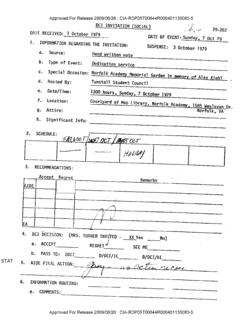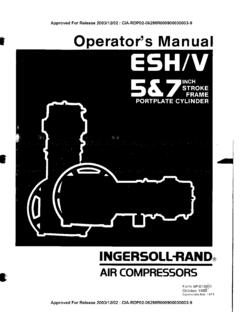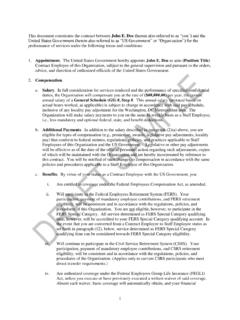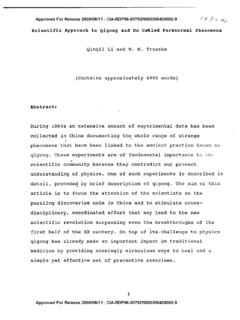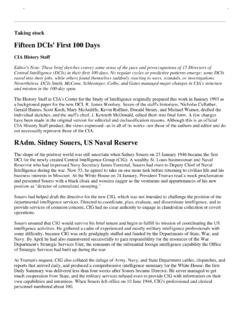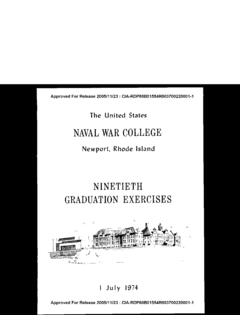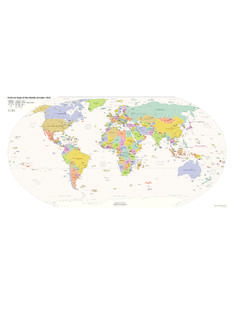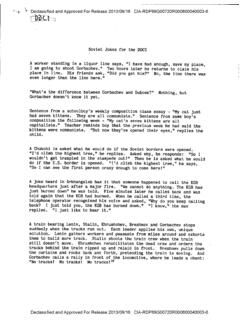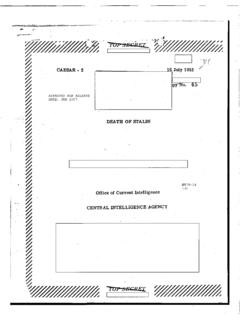Transcription of BASIC PRINCIPLES OF EXPLOSIVES - Central Intelligence …
1 BASIC PRINCIPLES OF EXPLOSIVESIt is a well-known fact that matter does not vanish, rather it changes form, itchanges from liquid to gas. Many of these natural elements have a great amount ofhidden energy. Should this energy be harnessed and released, many things can beachieved if utilised process of changing this energy from one form to another can be calledan explosion. This takes place when we release this inner hidden energy in a suddenand prompt manner, to have an effect on the surrounding atmosphere. Therefore wecan say that the explosive is a prompt release of energy, but not every prompt releaseof energy is an we define the explosive compounds or mixtures as materials that have thefollowing characteristics:?1An enormous ability to produce gases under extreme amounts of capability to produce these gases in a very short or instantaneousperiod, in order to exert pressure on the surrounding scientific reasons we divide the explosive materials into the materials, gun materials that require detonation dynamiteFACTORS AFFECTING THE of the elements (compounds) in the and of the explosive between the size of the explosive material and the container in which it of the that could have a negative or a positive OF EXPLOSIONS: This is a process where materials convert into greatamounts of gases, reaching 10-15,000 times the original size, instantaneously( 1/10000 of a second), as previously (PHYSICAL) EXPLOSION.
2 This is an explosion resulting from apressure build up in a sealed container gas or vapour release from a pressurecooker, or placing a flammable substance in a sealed container , the burningwill produce gases that cause the container to explode, or explosions from thingslike gas cooking canisters which can take place if it is EXPLOSIONS: This is a process of splitting the nucleus of theexplosive material, coupled with great amounts of temperature, the AND REGULATIONSMost chemicals are poisonous and dangerous to a various degree depending on itstype. Chemicals exist in solid, gas, or liquid forms. Some chemicals catch fire easily toproduce poisonous gases. Others react with air, water or with each other to produceheat or an explosion; therefore general information about safety can make learningeasy and of the EXPLOSIVES are dangerous and poisonous potassium cyanide ifinjected into the acid (H2SO4) will burn any organic burn at 25oC and catch fire upon chlorate (KClO3) explodes by rubbing chemicals (gases, liquid & powder solids) react with each other.
3 Exposed to moist air will and understand experiment several times before you perform should be done in an open and well ventilated area because mostof these experiments produce harmful have a container or bucket full of water sudden rises in temperature occur and it goes out of control, then just pourthe contents into a bucket of be patient and take your mouth familiar with the materials you are milk after experiments that involve poisonous gases. It has a cleansingaffect on your instructions to the gloves and an bottle from top and bottom so that you do not drop must be supervised by experienced people. This is must be done calmly and small quantities for experimental purposes, (in case of accidents, damagecan be easily contained). t throw acid on nails must be kept cut and t rub your eyes or skin, also wash hands with soap at t be curious with chemicals - don t mix chemicals for the sake of containers tightly - don t exchange covers or mix the an incident occur, notify the instructor with a screw on lid must be cleaned first aid kit should be available in case of lab clean and organisedGENERAL at room temperature 20-25oC in a dark sealed materials can be stored in water - refer to the chemical characteristic ofthe particular chemical.
4 This is usually done for storage in hot ice pack is a container with ice and water in which we place the containerrequired for cooling to bring down the hot water bath is used to heat some chemical compounds by placing themin a container , then placing that in hot water to bring the temperature up torequired amount, TNT melts at 71-81oC, or some napalm heating method can be used by placing the container directly on thesource of heat. Pyrex dishes can be used for heating is used by placing a metal plate over the heat source, is done using a glass or clay sure all apparatus is clean and dry before and after use electrical grinders for grinding chemicals. Use wood or clay pestaland mortar set, but not metal as this may react with add the heavy material to the lighter material sulphuric acid tonitric acid, not the other way reading the temperature it should be done a little below the surfacewhere the reaction takes OF THE EXPLOSIONTHE MAIN a charge is exploded it produces large amounts of gases one cubiccentimetre of explosive gives 10-15000 cubic metres of gas in a very short time,measured as 1/1000 of a second.
5 The speed of this is up to 10,000 km per hour,causing pressure @ tonnes per cc in the centre of the explosion. This enormouspressure destroys anything within its has two phases:1. Positive phase - caused by the outward rush of these enormous gases, whichcauses the majority of the Negative phase - caused by the inward rush of the surrounding air to fill thevacuum caused by the positive we detonate a charge underground or under water, enormous amounts of gases,heat and shock waves are produced which is similar to a minor earthquake. Becausethe earth or the water cannot be compressed the destruction effects the immediatesurroundings we detonate the same amount of charge in the open air, it will produce the samedestructive power and the effects will be felt over a larger distance. This is becausethe air can be compressed which enables the reaching of further distances, but withless effect will vary according to the nature of the explosive material.
6 In slow workingexplosives it takes longer, which enables it to be more effective on its is because some materials need to reach a certain temperature before becomingeffective. These slow EXPLOSIVES give it time to reach the desired temperature. Whilethe detonation with the fast EXPLOSIVES will create more heat and have less burningeffect on the surroundings because the speed does not allow the temperature of thematerial to EFFECTS1. cause the explosive waves to follow the same pattern as that of sound orlight waves. This reflection causes the destructive wave to lose power and get weakertill it vanishes. This characteristic is utilised by the military in digging trenches fordefence in with temperatures up to 3000oC produce fire on contact with flammablematerials petrol tanks. Also the destructive waves can cause electrical currents orshorts that in turn cause FRAGMENTATION.
7 This depends upon the explosive substance, where the explosion caused by the fastmaterial will cause more and even fragmentation, while the slow explosion will cause3less and unequal fragmentation. We can increase the effect by using easilyfragmentable metal shrapnel from military grenades or shells. These must alsohave the proper thickness the container , which allows the build up of thetemperature and pressure inside, which in turn will speed up the process of explosion,in order for the explosion to take place before fragmentation. This process can befurther helped by making grooves in the inside of the container (usually metal forthese purposes ), pineapple grenades. Or items such as nails or ball bearings canbe used and attached to the outside of the container , also rusted metal pieces orpoisonous pieces can be utilised for maximum is worth noting that half of the power of the explosion is consumed in thefragmentation process.
8 The other half is used to propel the fragments. Containers willnormally expand to one an a half times their normal size before fragmentation. EXPLOSIVESE xplosives are considered to be the best weapons in guerrilla warfare because oftheir effectiveness and efficiency. EXPLOSIVES are chemical elements, compounds orphysical mixtures that have the ability to convert to enormous amounts of gases in avery short time (1/1000 of a second) that takes place by external activator. Thiscauses extreme pressure in all OF EXPLOSIONA chain of EXPLOSIVES is an arrangement of explosive materials where each explosivedepends on the one before it, starting from the fuse ending with the main explosion(main charge) to take place and if we miss one explosion of this chain the explosive ofthe main charge will not take place or the chain of the explosion will be broken andstop.
9 The sensitivity of the material involved in this chain of explosion will decreasethe activator, which is the most sensitive material in the chain. To end up with themain charge which is the least sensitive, on the other hand the destructive powerresulting from each of the explosions in the chain will increase as we go away from theactivator to end up with the main charge that has the most destructive power. Forexample the explosive chain in the detonator is made of 2 or 3 stages first stage is aflammable material which can be easily excited externally that in turn will cause theactivator which is the second stage in the chain to blow up creating enoughdestructive power to start the explosion in the booster stage which is less sensitivethan the activator but has more power.
10 This destructive power is enough to detonatethe main charge, which is less sensitive than the booster but have more destructivepower. The idea in the chain of explosion is to start it with the material that can beeasily OF EXPLOSIVESE xplosives can be classified according to the following1. THE NATURE OF EXPLOSIVE Solid form. , RDX, KClO3. Plasticine (dough) form, C3, C4 and Gelignite. Liquid form Nitro glycerin, nitro methane, and nitro benzene. Gas form Hydrogen (H2), Natural gas (CH4) or THE SPEED OF THE EXPLOSIVE Fast explosive the speed is faster than 1000m/s TNT, dynamite. Slow explosive the speed is less 1000m/s gun TYPE OF BOND Chemical compounds in which compounds or elements cretincharacteristics form a new material, which has different characteristics of theoriginal materials, and can not be separated easily.
